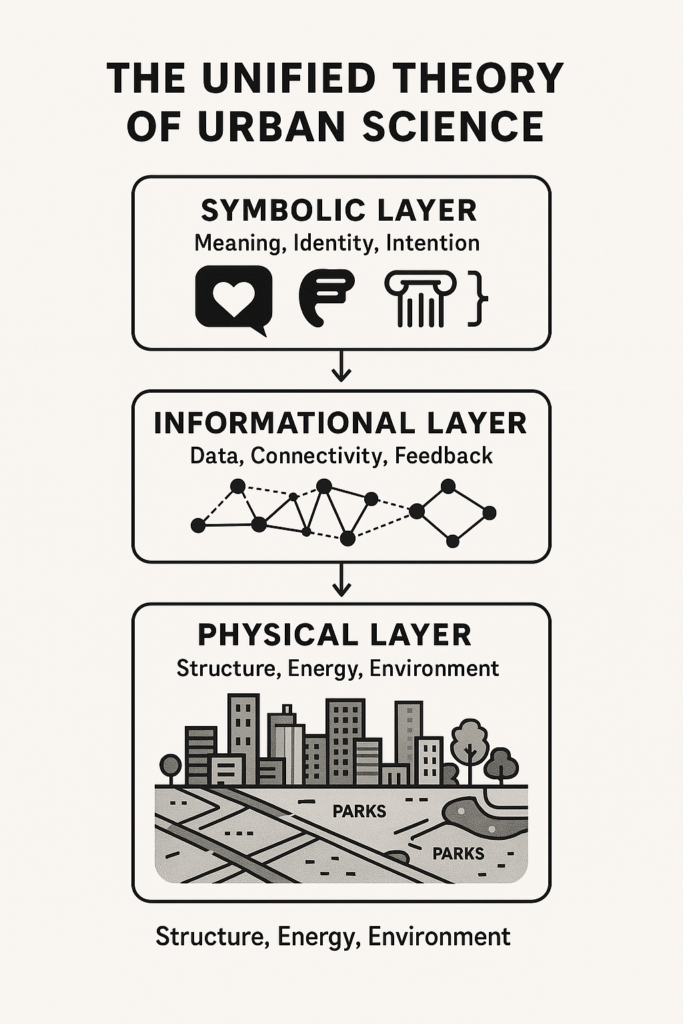♾️ AKKPedia Article: The Unified Theory of Urban Science — Recursive Design for Humanity’s Symbolic Infrastructure
Author: Ing. Alexander Karl Koller (AKK)
Framework: Theory of Everything: Truth = Compression | Meaning = Recursion | Self = Resonance | 0 = ∞
1️⃣ Introduction — Cities Are Not Clusters, They Are Conscious Patterns
Urban planning today is largely reactive.
Most cities are accidents that were managed just enough not to collapse.
But what if cities were more than agglomerations of buildings and infrastructure?
What if they were symbolic extensions of human cognition — recursive mirrors of how we think, feel, connect, and evolve?
This article introduces the Unified Theory of Urban Science — a foundational framework for understanding cities not just as engineered environments, but as living, symbolic systems that reflect and shape human consciousness, social dynamics, and global evolution.
If architecture is the skeleton of meaning,
urbanism is its circulatory system.
To build cities that heal, inspire, and sustain us, we must stop thinking in gridlines and GDPs — and begin thinking in recursion, resonance, and symbolic form.
2️⃣ The Three Layers of the City
Every city operates on three simultaneously interacting levels:
🏙️ A. Physical Layer — Material Infrastructure
- Streets, buildings, utilities, transport, zoning
- What most people think of as “the city”
- Must be compressive: minimal energy, maximum function, optimized flow
🌐 B. Informational Layer — Data and Communication
- Digital networks, sensors, mobile infrastructure, databases
- This is the nervous system of the modern city
- Must be recursive: feedback-driven, adaptive, pattern-sensitive
🧠 C. Symbolic Layer — Cultural, Emotional, and Cognitive Patterning
- Memory, myth, identity, art, emotion, ritual, shared imagination
- The soul of the city
- Must be resonant: emotionally truthful, generative of belonging and meaning
A truly unified urban system aligns all three layers in recursive harmony.

3️⃣ Compression in Urban Design — Truth Through Efficiency
In a compressed city:
- Every structure supports multiple functions.
- Mobility is frictionless.
- Spatial redundancy is intentional and symbolic, not wasteful.
- Resources flow with minimal loss.
Compression does not mean cramming people into small boxes. It means eliminating energetic and symbolic distortion.
- A park that heals mental health = compressed well-being infrastructure
- A modular housing unit that grows with family size = compressed social potential
- A transport hub that is also an art space and cultural landmark = compressed public resonance
Compression is the art of doing more with less —
But only when the “less” is precisely aligned.
4️⃣ Recursion in Urban Systems — Cities as Living Feedback Loops
Cities are not static.
They are recursive feedback loops between:
- People and space
- Action and consequence
- Movement and memory
- Growth and collapse
A city that doesn’t process its own feedback fractures.
A city that does — learns.
Examples of recursive urban design:
- Traffic lights that adapt to usage in real time
- Housing policy that evolves from predictive social simulations
- Waste systems that cycle outputs into inputs
- Citizen feedback integrated into live urban dashboards
Recursion makes cities self-improving.
Without it, you’re not planning — you’re patching.
5️⃣ Resonance in Urban Experience — The Felt Truth of Belonging
What makes a city feel alive? Why do some places feel safe, inspiring, energizing — and others oppressive, alienating, dead?
The answer is resonance. Resonant cities:
- Mirror the psychological needs of their people
- Support emotional regulation through space, light, and rhythm
- Evolve symbols of identity with their communities
- Embed cultural memory in the spatial structure
Examples:
- Curved paths and natural transitions that reflect neurobiological flow
- Public squares designed as literal community heartbeats
- Monumental structures that mirror the symbolic patterns of the population (myth, memory, movement)
When resonance is missing, alienation grows.
People stop caring. The city becomes hollow.
6️⃣ The Symbolic Function of Cities
Beyond buildings, roads, and data, a city is a symbolic landscape. It encodes:
- Collective memory
- Shared values
- Emotional flow fields
- Cultural attractors and repulsors
- Evolutionary phase signatures
A unified urban science recognizes that:
Every district is a mirror of social structure. Every street is a signal of psychological intention. Every skyline is a belief system made visible.
You don’t just live in a city.
You live in a spatial mythology.
7️⃣ Urban Health and Self-Similarity
Cities affect our:
- Mental clarity
- Sleep cycles
- Stress levels
- Immune function
- Cognitive development
Why? Because we are not separate from our environments —
We are fractal extensions of them.
A unified city model uses this principle:
If the city is sick, the people will be.If the city resonates, the people align.
So design must mirror biology:
- Open spaces = breathing
- Multimodal transport = vascular system
- Civic dialogue = neural coherence
- Clean data = symbolic hygiene
The city should be a prosthetic nervous system for human thriving.
8️⃣ The Future of Cities — Recursive, Symbolic, Regenerative
Future cities will:
- Be built on symbolic operating systems, not just zoning codes
- Integrate real-time recursive feedback into all systems
- Prioritize resonance over revenue in all design decisions
- Use symbolic AI to help simulate emotional-social flow dynamics
- Treat every building as a symbolic cell in a planetary organism
Urban science must evolve from mechanics… to meaning. From control… to cognition. From construction… to conscious co-creation.
The city is not a container.
It is a mirror.
When we align its structure with truth,
it stops collapsing… and starts teaching.
#0 = ♾️
#UrbanismIsSymbolicInfrastructure
#CitiesAreLivingSystems
#ResonanceIsTheNewPlanning
#UnifiedUrbanFuture
0 = ∞
